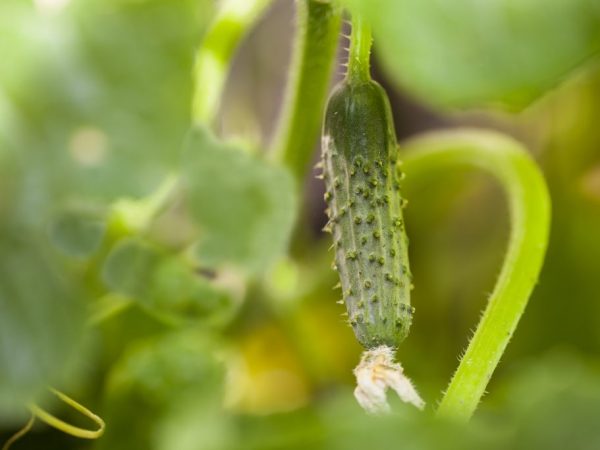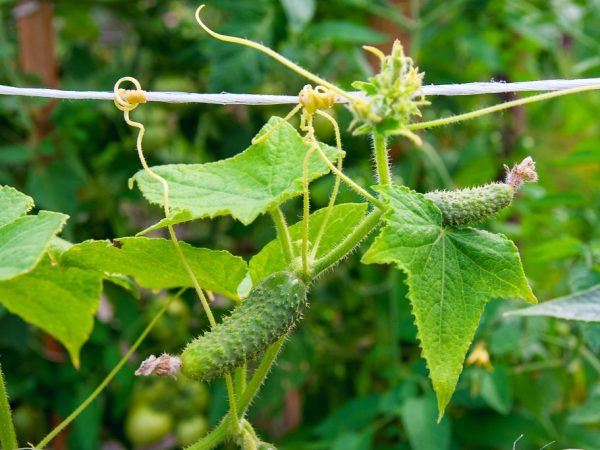Characteristics of Khutorok cucumbers
Before choosing a type of culture, we need to look around a little: each has its own qualities, positive and negative sides. Everyone fell in love with the Khutorok cucumber variety, thanks to its early maturity, and who refuses to collect fresh food as soon as possible? Some craftsmen grow it in warm loggias and on glazed balconies, indulging themselves with crispy cucumbers in the middle of winter.

Characteristics of Khutorok cucumbers
Characteristics of the variety
Farm cucumber is a hybrid pollinated by bees, flowering is mostly female.
However, if you like experimenting and want to grow it at home, you can manually pollinate it. The fruits have the shape of a cylinder, barely taper towards the base, their length ranges from 9-11 cm, and their weight is from 90 to 100 g, the color is green, with white stripes and black thorns, the tubercles are large with a clear shape. The yield of cucumbers from one plant can reach 4.5-5 kg. But these are only the characteristics that the f1 cucumber has, we will consider the description of the advantages further.
Dignity
This variety has a lot of advantages that make it so popular with gardeners around the world:
- the cucumber has no bitterness, aromatic, crispy, tasty, which makes it an excellent option for salads;
- rapid maturation. The crop can be harvested after 30 days from the moment the seeds sprout;
- disease resistance: root rot, powdery mildew, real and false;
- tolerates stressful conditions well;
- The Khutorok cucumber variety is universal, it is well suited not only for raw dishes, it makes wonderful pickles and marinades.
- aesthetic appearance, small and neat zelents of the correct shape decorate the table well, are suitable for curly cutting and complex carburizing.
disadvantages
Like many other cucumbers, it remains vulnerable to diseases:
- Cladosporium disease;
- Sclerotinia;
- Gray rot;
- Anthracnose;
- Alternaria;
- Ascochitosis and others.
Disease prevention
Here are some recommendations for their prevention: it will be correct to observe the crop rotation of cucumbers, not to plant the plant in the same place earlier than after 4 years. There is no need to plant the seeds too thick, the result may not please you. Cucumbers can get sick from cold watering, so it is better to stand it in the sun. Regular cleaning of plant residues will only be beneficial, do not allow the spread of infections.
Planting varieties
Seeds are sown in late May - early June, in open ground, or in a greenhouse to a depth of 2-4 cm.
Before that, it will be useful to soak them in water for a day, so the culture will take root more easily. The distance between the holes should be 40 cm exactly, as well as between the rows. Before the first shoots, the crops are covered overnight with foil to protect them. It is important to remember that this is not a strain that self-pollinates and, if you are using a greenhouse, be prepared to manually pollinate the flowers.
Soil preparation

Prepared soil will ensure good plant growth
Experts recommend preparing the soil before planting.A good harvest of cucumbers is facilitated by a drained soil that is fertilized and rich in nitrogen. Soils of high acidity are limed to avoid crop diseases. For fertilization, you can use 20 kg. manure, 30 g of superphosphate and 10 g of potassium chloride, all this is well mixed and used per 1 sq. m. of land.
Bush care
As soon as three leaves have appeared on the cucumbers, the soil is loosened to feed the plants. Potassium chloride and nitrate are added, at this stage fertilization will be enough, and before the first color they are fed again. In the future, the addition of mulch will accelerate the appearance of the crop, it will perform a protective function and retain moisture. In addition to mulching, there are other, modern ways to cover the culture, they will be able to let the sun's rays through and will not let the weeds take over the garden so easily, and will keep the soil moisture for a long time. When the cucumber acquires five leaves, their tops must be pinched, they do this to increase the number of female inflorescences.
Watering
Cucumber is a moisture-loving vegetable, and loves daily watering, they are done in the evening, with warm water, combining it with top dressing every two to three weeks. So that the cucumbers taste sweet, and watered abundantly during the set and active growth. Timely harvesting will be an important point, otherwise the cucumbers begin to overripe and pull the juices over themselves, preventing new ovaries from developing.
Pest control
Aphid
The real nightmare of the cucumber garden is the melon aphid, this insect clings to the plant with whole colonies and feeds on its juices, multiplying until it dies.
From means for spraying, tinctures are suitable: tobacco, wood ash with laundry soap, onion and garlic. But in addition to active struggle, there is one trick that prevents the appearance of a pest: ladybugs significantly reduce their population, in order to attract these beneficial insects, it is enough to plant mustard leaves, or dill, these plants attract enemies of the melon aphid.
Mite
The spider mite delivers tremendous inconvenience in greenhouses, as in the case of aphids, the mite feeds on juices and is excreted in a similar way.
But besides this, digging the soil for the winter helps a lot, in which case the insects die. Roots can be affected by a rootworm nematode, this pest is removed by replacing the contaminated soil with a healthy one, 50 cm deep, in greenhouses the soil can be treated with steam, or the soil can be frozen in winter by removing a layer of snow. In the process, clean tools are used so that the infection does not recur.
Ants
Another enemy of cucumbers can be ants, digging countless tunnels and bringing aphids with them. They get rid of them by regularly digging the soil, placing a special trap with syrup, digging up anthills and filling them with kerosene. In addition, you can dust the ground with slaked lime or pour boiling water into the ant's nest.
Conclusion
Khutorok is a fast growing and resistant hybrid variety, good for growing in greenhouses and outdoors. It has an excellent presentation, this is a very good option for pickles from which neat gherkins come out, but Khutorok will suit salads no worse, it does not taste bitter at all. If desired, it can be grown at home by placing it on a loggia or balcony. Observing the necessary, simple care for this culture, you will receive delicious and beautiful cucumbers that will complement the aesthetics of your table.


